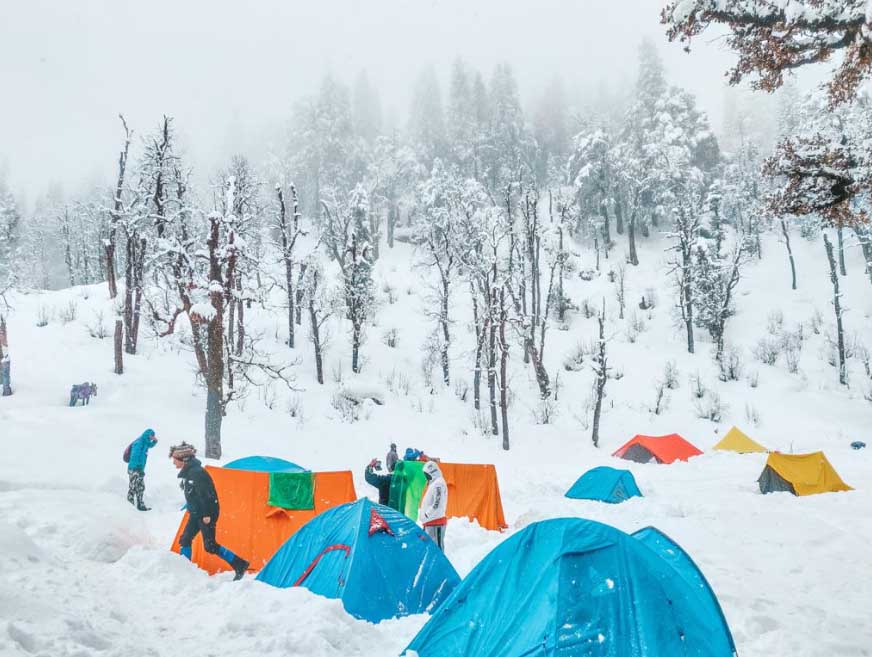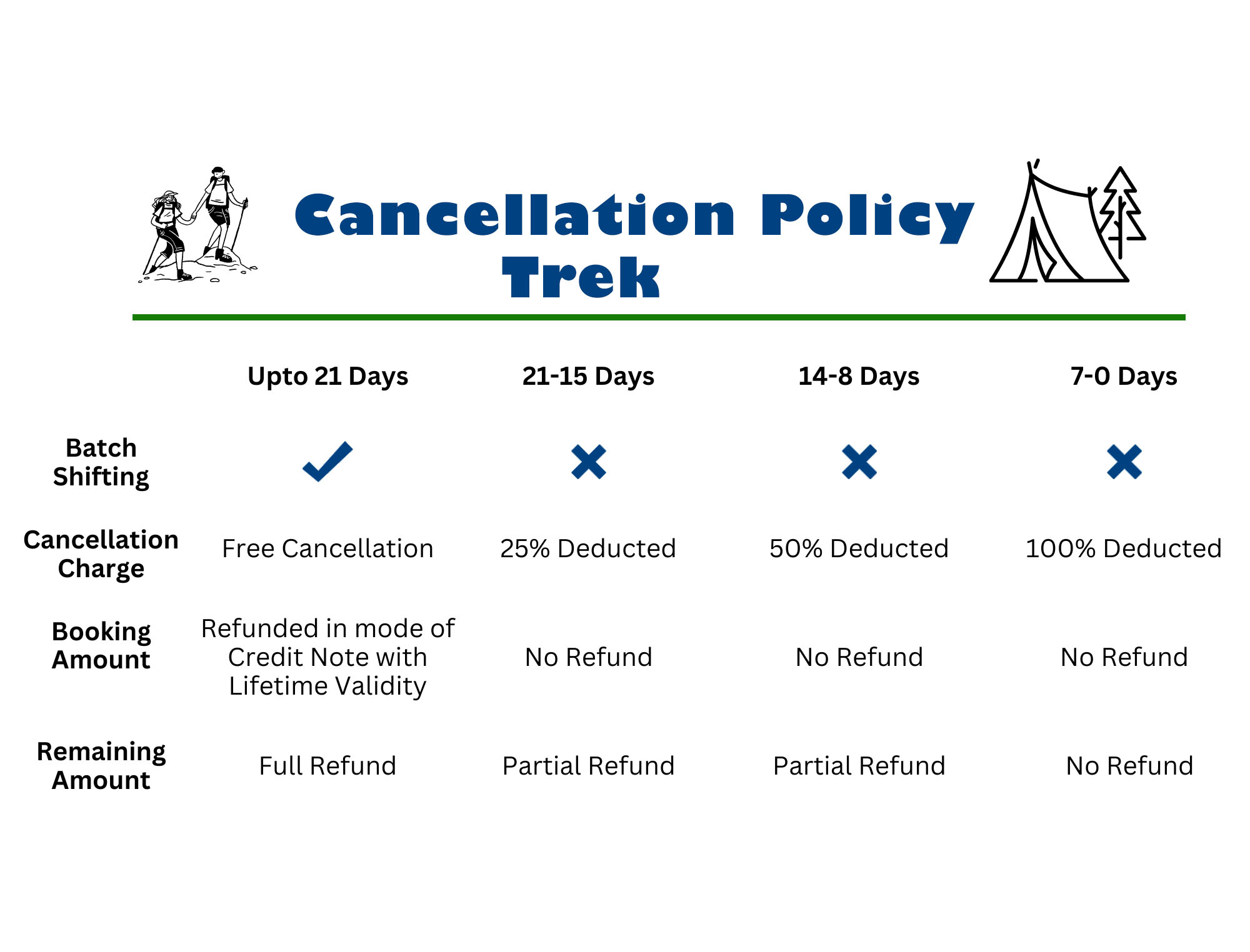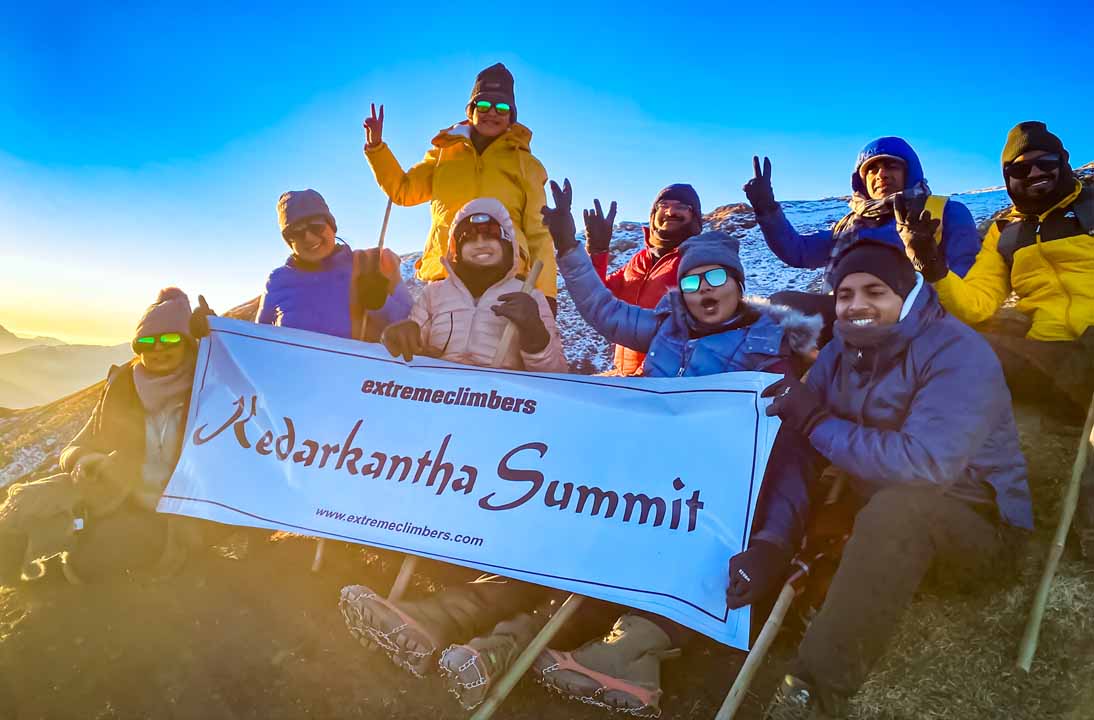-
Kedarkantha Trek
sankri Uttarakhand (500+ Reviews)
-
Trek Fee
7,500
| altitude : | 12,500Ft. |
| duration : | 5 days |
| Trek difficulty : | Easy to Moderate |
| Yatra length : | 20kms |
| Best Months : | Nov – March |
Overview
Elevated at 12,500 ft. Kedarkantha is one of the majestic peaks of the great Himalayan range. One of the most popular winter treks, Kedarkantha fascinates numerous hikers and trekkers from all over the country and is perfect for both beginners and experts.
This 4-night 5-day trek is curated after keeping in mind the wishes of people who love the serenity as well as the adventure that nature, with its unpredictable trails and mystical valleys, can provide them.
Popular because of the spectacular view of snow-capped mountains that it offers after finishing the trek, some of the ranges that are visible from the summit are Black peak, Swargarohini, Gangotri, Yamunotri ranges, etc.
The subject of many mythical stories and legends that are mostly associated with Lord Shiva, the name of the summit translates to “The throat of Lord Shiva”. The local myths and folklores just add more to its charm and make the experience even better.
On this long weekend trip to Kedarkantha, we begin our journey from Dehradun to make our way to the small village of Sankri which is the base camp for this 20 km long trek. We will spend a night at our designated homestay or hotel, introducing ourselves and exchanging stories before retiring to bed for the night.
The next day, after a briefing session from our trek leader, we will proceed towards our first checkpoint Juda ka Taal, and spend a leisure day at the campsite, having lunch as well as dinner. We will have an amazing view of the ridges of the Swargarohini mountains.
The next morning, we will begin our trek to the Kedarkantha base camp which is elevated at a height of 11,200ft above sea level. After feasting on hot lunch and indulging in fun activities like snowball fights, we will prepare for an overnight stay at the base camp itself.

Finally, after witnessing the highs and lows of this brief trek and watching magical sunsets, we will begin our trek to the Kedarkantha summit before dawn pours all over the sky as the best part about this entire Kedarkantha trek package is the early sunrise that you get see after reaching the top. Trust us, it makes you forget all about your exhaustion and you will feel entirely at peace with yourself.
One thing that separates the Kedarkantha trek from the rest of the treks is that it falls under the category of a moderately difficult trek. So, it is beginner-friendly and it rewards you with a mesmerizing 360-degree view of the great Himalayan ranges, making the experience satisfactory all over.
The coldest area along the trek route has to be Juda Ka Taal with the Taal being completely frozen during the winter months. The sunlight glistens on the surface like diamonds giving it a golden illumination. Even after that, the path only becomes more beautiful and you can enjoy picturesque views all along the way. You might encounter snowfall if you are lucky enough but it depends entirely on the weather which can be unpredictable.
People who come to Kedarkantha can never stop themselves from coming back over and over and it’s not just because of the summit, but also because of the local culture and of course the cuisine. The famous Red Rice that is homegrown in Kedarkantha regions keeps the body warm and is a must-try when going on this trek.
It is advised not to carry electronic devices that could only be used with network connections or are majorly dependent on them. The reason is that the network vanishes just before reaching Sankri Village, which is the starting point of the whole trek.
So, if you’re carrying all that electronic stuff such as a phone, laptop, and wifi dongles, then there’s a high chance that they’ll end up getting discharged and would only add to the extra baggage, weighing you down.
Although the Kedarkantha trek is accessible all year long, the majority of people prefer visiting during winter to witness the ivory snow, mainly in December and January but the best time to visit Kedarkantha is from November to February.
Kedarkantha trek is one of the few places where one cannot capture the full essence of the experience on their first visit and hence, trekkers repeatedly keep coming back here.
Lastly, going by the popular opinion and the mass appeal of the Kedarkantha Trek, one can easily categorize it as ‘The Best Winter Trek to do In India’. So, if you’re overwhelmed with multiple choices of winter treks to do in India and are confused about ‘what to choose, then Kedarkantha should be an easy choice.
So, make some room for Kedarkantha Trek in the year of 2023 travel bucket list you have on your wall, and keep your backpack ready for this winter season.
Itenirary
- The group will assemble at the pickup point at 06:00 AM.
- We’ll drive towards Sankri village which is the base camp for the Kedarkantha Trek.
- Upon reaching Sankri, we’ll check in to our designated homestay. The rest of the day is at leisure and travelers are advised to rest.
- In the evening, Dinner will be served followed by an overnight stay in Sankri Village.
Note: The pickup point will be Dehradun Railway Station. (tentative)
- After early morning breakfast, a small briefing session would be conducted by the trek leader where all the necessary details about the rest of the day will be shared.
- We will start our trekking journey. En route to our campsite, we’d be traversing through lush green forests consisting of pine trees with the Swargrohini Massif in the backdrop beckoning you closer.
- We will reach Juda Ka Taal after five hours of trekking. Upon reaching our campsite, we will have lunch.
- The rest of the day is at leisure. Dinner will be served in the evening followed by an overnight stay at Juda Ka Taal Campsite.
- The day will start with morning tea followed by breakfast.
- The Trek Leader will give you a briefing about the day before we proceed.
- Afterward, we’ll start the trek towards the Kedarkantha Base Camp, which takes about 3-4 hours.
- Upon reaching and checking into the campsite, we’ll have a warm lunch.
- The rest of the day is at leisure and we’ll relax by indulging in activities like snowball fights and other fun games.
- Lastly, we’ll have dinner at the campsite followed by an overnight stay at Kedarkantha Base Camp.
- We will finally begin our trek towards Kedarkantha Peak.
- We’ll get up at 02:00 AM as we’ll be needing an early start.
- Afterwards, the group will trek up to the Kedarkantha Summit.
- After reaching the summit, we’ll enjoy the view from the top and witness the beautiful sunrise from the summit.
- Shortly afterward, we’ll head back to the Kedarkantha Base Camp once again.
- Upon reaching, Lunch will be served at the campsite.
- It’s the last night at the campsite so we will have a farewell bash.
- Overnight stay at Juda ka Taal campsite.
Additionally, you get a 360-degree view of the whole Himalayan Region from the Kedarkantha Top. Some of the peaks are Gangotri, Swargarohini, Banderpooch, Kinner Kailash, etc.
- After early morning breakfast, we’ll head down towards the Sankri Village from Juda ka Taal.
- Upon reaching Sankri, we’ll stop and freshen up at our designated hotel, and lunch will be provided.
- Shortly afterward, we’ll proceed towards Dehradun. (Reach Dehradun by late evening.)
- The group will disassemble here and be on their separate ways with a heart full of contentment and a mind full of memories.
Location
Photos
INCLUSIONS
Inclusions- Accommodation: 1 Night in a Hotel / Homestay on a triple/quad sharing basis. 3 Nights accommodation in a tent on a triple sharing basis.
- Transportation: Surface transfer from Dehradun – Sankri – Dehradun by Sumo / Bolero / Tempo Traveler ( Depends on the number of travelers).
- Meals: All Meals from (Day 1 Dinner to Day 5 Lunch) are included. We provide simple nutritious vegetarian food on all days of the trek.
- Snacks: Morning / Evening Tea / Coffee with light snacks and soup while on the trek.
- Camping logistics: Tent, Sleeping bags, Mattresses, Dining tent, Toilet tent.
- Trek Leader Qualified and Experienced Trek leader and support staff.
- Permits: All necessary fees and permits.
- Trekking Equipment: Gaiters, Micro Spikes, and Rope if required.
- Safety Equipment: Basic First Aid kit with Oximeter and Oxygen Cylinder.
- Guide ratio: 1:10
EXCLUSIONS
Exclusions- Any expenses of personal nature.
- Meals during transit.
- Insurance of any kind.
- Unscheduled delay due to landslide.
- Cost Escalation due to “ Force Majeure and Evacuation charges”.
- Anything not mentioned explicitly in the above program.
- *You can apply for travel insurance prior to the trek.


THINGS TO PACK
- Backpack (Min 55 Ltrs with rain cover): You must pick a good quality backpack with a comfortable fit and straps that won’t give you shoulder pain. You can check out your nearest Decathlon store for a good trekking backpack.
- Day backpack (20 – 30 Ltrs): When you head towards the summit, you are required to carry only a few necessary items and for that, you need a day backpack as you will leave your bigger one on the campsite.
- Floaters or Sandals: Although the entire trek requires a good quality shoe, you still need to let your feet breathe to avoid chafing and blisters. When you are at the camp, a good pair of sandals and floaters will help you to move freely.
- Trekking Shoes: A good trekking shoe is comfortable, provides ankle support, and has a good grip as well. They shouldn’t be chunky, instead, they should be lightweight and sturdy.
- 3 Quick Dry Tees: You must keep at least three pairs of quick dry tees so that you can wash them in between stops for proper hygiene.
- 2 Track Pants: A good pair of track pants made of polyester will let your skin breathe. They’re lightweight, dry easily, and comfortable to walk around in. You can easily avoid chafing and rashes by investing in a good pair of track pants.
- 3 Pair of Cotton Socks: Cotton socks are extremely comfortable to move around in and are lightweight as well which is why you can always count on a good pair of cotton socks while trekking. However, keep in mind to change them and avoid wearing them when they are wet.
- 1 Pair of Woolen Socks: A good pair of woolen socks, especially merino, are comfortable, limit odors and provide adequate insulation from the cold so you can wear them at night.
- 1 Poncho: A poncho is an evolved form of a raincoat that provides coverage to your body as well as your bag and ensures total water protection from rain.
- 1 Heavy Jacket: It’s emphasized that you need to carry proper layers so you can avoid getting cold which is why you need to carry a heavy jacket that you can put on over your other clothes.
- 1 Pair of Thermal: Thermal is a piece of garment that helps in keeping your body warm in cold temperatures. It is a necessary item that you need when going on a high-altitude trek.
- Quick-dry towel: A quick dry towel will help in maintaining proper hygiene. It must dry quickly because the wet fabric will only increase the chance of bacterial growth.
- Windproof Jacket: As you ascend towards high altitude, you get hit by chilly winds and a windbreaker jacket is designed to resist them. They are lightweight and are made of synthetic fibers.
- Woolen Cap: A woolen cap will help prevent cold when you ascend to high altitude. You can also cover your ears to avoid any pain and discomfort you might face in them when going at high altitudes.
- Gloves: Insulated gloves help in maintaining proper body heat in your hands and also provide a better grasp on trekking poles.
- Sun Cap: A lightweight sun cap with side flaps is perfect to keep your head cool and avoid sunburns on a sunny day.
- 1 Scarf or Balaclava: Along with sun rays and chilly winds, you also get hit by dirt and grime during treks which is why it’s important to carry a scarf or balaclava so you can cover your face when needed.
- Lip Balm: Your lips can become chapped due to the harsh cold winds so it’s important to keep them moisturized.
- Cold Cream & Sun Screen (SPF 40+): To avoid sunburns and chafing, you need to put on sunscreen as well as cold cream.
- Antibacterial powder: To avoid rashes that develop from a bacterial infestation in your armpits and other parts of your body.
- Water Bottle 1 Lt.: Hydration is extremely important when it comes to trekking. Carrying a water bottle that you can refill with Himalayan water is a must.
- Headlamp or torch: You can’t rely on moonlight when you are in the mountains. A torch or even a headlamp with a fresh pair of batteries is always a good idea to bring along.
- Bag for all your Toiletries: A bag with all your essentials including napkins, toothpaste, sanitizers, paper soap, etc should be carried in a ziplock bag.
- Personal Medications and basic medical kit: A few cuts and bruises are almost inevitable when you are on a trek so carrying a medical kit with bandages, Dettol, etc is necessary.
- Dark Sunglasses / People who use spectacles (Use Photochromic glasses instead of contact lenses): Photochromatic glasses are specs that are designed to transform into anti-glare shades depending upon exposure to the sun. They are good when it comes to eye protection but one can also opt for clip-on glasses etc.
- Trekking Pole: The trekking pole assists in more than one way. It saves energy while also providing stability and helps you to maintain proper balance.
- Documents: Identification proofs like Aadhar Card, Drivers License.
- Extra Polythene: In case your clothes get wet or your garments don’t dry, you can carry them in polythene. However, make sure that all the plastic that you are carrying into the woods leaves with you. Don’t litter in the mountains.
- Camera: This should be obvious. To make sure that you get to capture all the great moments from your trek. Make sure that you have enough storage and some extra batteries as well.
Reviews

Wilson
Had a great experience with Pradeep bhai from sankri guide modi ji

Ajay Kandari
Good experience with extreme climbers

Mohit Singh Chauhan
Nice arrangement and humble ,experience, And supported guide . It’s been most adventurous trip for us thanks to rocking extreme climbers ☺️😊

Mayank Mamgain
This was my second trek har ki dun and man… It was mind blowing. The scenery was beautiful and lively all through-out the trek…..


